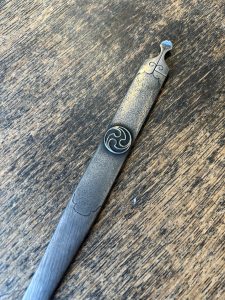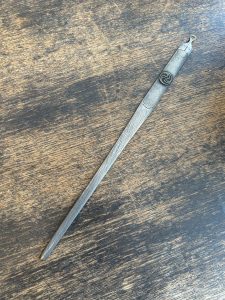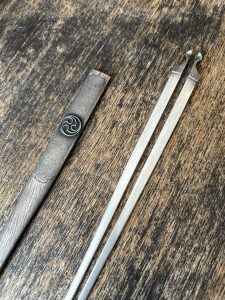笄(こうがい)とは(愛知県名古屋市千種区姫池通 骨董買取 古美術風光舎)
2025.03.26
昨日からの黄砂のせいでしょうか、目に違和感があり涙が止まりません。黄砂は花粉に比べかなり小さいため体内に入り込みやすく呼吸器疾患やアレルギー症状が悪化するとも言われています。
また砂漠の砂ということで鋭利なガラス質の粒でできているため服にも付着しやすく手で払うだけでは取れにくいのだそうです。最近は注意喚起もされるようになりましたが、車に降り積もった黄砂はそのまま布で拭くとキズが付くことがあるので、たっぷりの水で洗い流す必要があるそうです。
温かい日差しに心弾む季節になりましたが、マスクから解放される日はまだまだ遠そうです。
さて先日から気になっておりました細長いかんざしのような、ペーパーナイフのようなお品。笄(こうがい)と呼ばれるものです。笄には女性の髪飾りとして使用されたものと、武士が身だしなみを整える道具として刀の鞘に付けられていたものがあり、いずれも室町時代に生まれたとされています。


写真の笄は刀に収められていた男性用の笄のようです。武士がまげを整えたり、頭を掻いたりするときに用いられました。先端部が耳かきの形に似ているなと思っていましたら「耳掻(みみかき)」という名称だそうで、実際に耳かきとして使われていたのでしょうか?その下の弦のようにくるんと丸まった模様が「蕨手(わらびて)」と呼ばれ、それにつづく地板の上に紋が施され、先に行くほど細くなっています。
笄は帯刀した時に体の外側に向く面にある「笄櫃(こうがいひつ)」に収められ、鞘の反対側の体に接する方には小さいナイフのような「小柄(こづか)」が「小柄櫃(こづかびつ)」に納められていました。江戸時代には「笄」と「小柄」、そして柄を握った時の調子を良くするための金具「目貫(めぬき)」を同じ意匠で揃えることが粋だとされ、この三つは「三所物」と呼ばれていました。
風光舎の笄は中で二つに割れている「割笄(わりこうがい)」と呼ばれるもので、店主に見せてもらった時は「SDGs?」「マイ箸?」と驚きましたが、箸として使っていたかは定かではないようです。しかし髪結い道具と耳掻きと箸を合わせたものを無駄のないスタイリッシュなデザインに仕上げたのだとしたら、今ならグッドデザイン賞をもらえるほどの出来ではないでしょうか。昔の人々のセンスは侮れません。

室町時代前期までは簡素な文様が多かった刀装具ですが、室町時代中期頃から芸術性の高いものが作られようになり、龍や獅子、花鳥や家紋などが施されるようになっていきました。素材も鉄や銅に代わり、金や赤銅(銅に金を加えた合金)などが用いられるようなります。
笄の地板と呼ばれる部分も、本体に直接文様を彫り込んだ「地彫(じぼり)」や、別に彫った紋を穴を開けた地板に打ち込んで組み込む「据紋(すえもん)」。薄い金属板に文様を彫り、完成してからはめ込む「地板嵌込式(じいたはめこみしき)」など時代と共に構造の変化があるようです。
耳掻の横の蕨手の文様も年代によって微妙に違っているため時代を特定する目安になっているとか。
このたった20数cmの小さな道具に、また私の知らない世界が広がっておりました。
それでは、また次の機会に。(スタッフH)
※この度、古美術風光舎では《うつわと骨董展》を店舗にて開催いたします。
《うつわと骨董展》
4月5日(土) 10:00~17:00 開催
4月6日(日) 10:00~17:00 開催
また、4月12,13日は覚王山春祭りも開催されており、春の覚王山界隈はとても賑やかに華やいでおります。風光舎も皆さまのご来店を楽しみにお待ち申しあげておりますので、お気軽にお立ち寄りください。
I have been feeling discomfort in my eyes and cannot stop crying, probably due to the yellow sand since yesterday. Since yellow sand is much smaller than pollen, it is said that yellow sand can easily enter the body and worsen respiratory diseases and allergy symptoms.
Also, because it is desert sand, it is made up of sharp, glassy grains that easily adhere to clothing and are difficult to remove simply by brushing them off with your hands. Recently, people have been warned that yellow sand that has fallen on cars can scratch them if wiped with a cloth, so it is necessary to rinse it off with plenty of water.
The warm sunshine has made my heart beat faster, but the day when I can be free from masks still seems to be a long way off.
Now, I have been wondering about a long and slender kanzashi-like hairpin or paper knife-like item. It is called Kougai. Kougai were used as women’s hair ornaments and Kougai were attached to sword sheaths as a tool for samurai to keep their appearance neat and tidy.
The Kougai shown in the photo seems to be a men’s Kougai that was kept in a sword. It was used by warriors for trimming their hair and scratching their heads. The tip of the Kougai looks like the shape of an earpick, and I wondered if it was actually used as an earpick. The rounded string-like pattern below it is called “Warabi-te,” and the crest is applied on Jiita, which becomes narrower as it goes to the tip.
The Kougai was kept in the Kougai-bitsu on the side facing the outside of the body when the sword was worn, and a small knife-like Kogara was kept in the Kogara-bitsu on the other side of the scabbard facing the body. In the Edo period, it was considered stylish to have Kougai, Kogara and Menuki, a metal fitting to improve the quality of the handle when held, all in the same design, and these three were called “Sanshomono”.
When the owner showed me the Kougai of Fukosha, I was surprised to see it as “SDGs” or “My chopsticks? When the shop owner showed me the Kougai, I was surprised, but I am not sure if they were used as chopsticks or not. However, if a combination of a hair-dressing tool, earpickers, and chopsticks was made into a lean and stylish design, it would be good enough to win a Good Design Award today. The taste of people in the past cannot be underestimated.
Until the early Muromachi period (1333-1573), most sword accessories had simple designs, but from the mid-Muromachi period (1333-1573), they began to be made with more artistic designs, such as dragons, lions, flowers and birds, and family crests. Gold and akado (an alloy of copper and gold) were used instead of iron and copper as materials.
Kougai’s Jiita (base plate) was also changed to Jibori (carved directly on the body) or Sue-mon (engraved by hammering a separately engraved design into a Jiita with a hole). The structure seems to have changed over time, including the “jiita inetshiki,” in which the design is carved on a thin metal plate and inlaid into the plate after completion.
The design of the bracken handles next to the earpickers also differs slightly depending on the period, and is used as a guide to identify the period.
This small tool, measuring only a few centimeters in length, has opened up a whole new world to me.
See you next time. (Staff H)
We are pleased to announce that we will hold the “Utsuwa to Kotto Exhibition” at our store.
The exhibition will be held on April 5 (Sat.).
April 5 (Sat) 10:00-17:00
Sunday, April 6, 10:00-17:00
The Kakuozan Spring Festival will be held on April 12 and 13, and the Kakuozan area will be very lively and colorful in spring. Fumikosha is looking forward to seeing you at our store, so please feel free to stop by.
*****************
ご実家の整理やお片付けなどをされている方のご相談などが多くございます。
お片付けなどくれぐれもご無理のないようになさってくださいませ。
風光舎では古美術品や骨董品の他にも絵画や宝石、趣味のお品など様々なジャンルのものを買受しております。
お片付けをされていて、こういうものでもいいのかしらと迷われているものでも、どうぞお気軽にご相談下さいませ。
また風光舎は、出張買取も強化しております。ご近所はもちろん、愛知県内、岐阜県、三重県その他の県へも出張いたします。
まずは、お電話お待ちしております。
なお、毎月21日の持込鑑定会では無料鑑定・買取・持込など、ご予約なしで承っております。
ご近所の皆さま、ご遠方のみなさまも、お気軽にお越しくださいませ。
愛知県名古屋市千種区姫池通
骨董 買取【古美術 風光舎 名古屋店】
TEL052(734)8444
10:00-18:00 OPEN
#出張買取#骨董#古美術#骨董品#絵画#版画#茶道具#刀剣#彫刻

